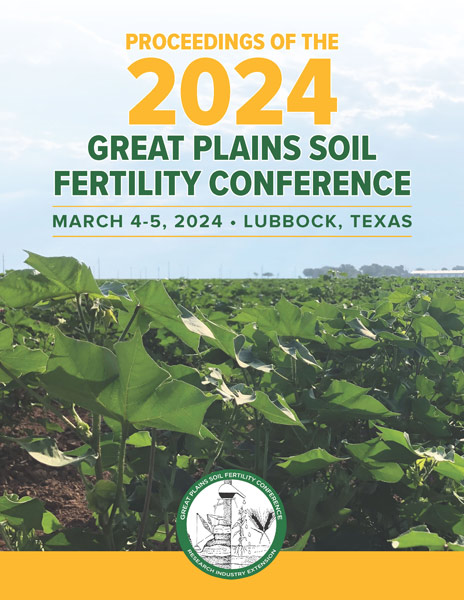Conference Proceedings Available!
Proceedings
Authors
| Filter results9 paper(s) found. |
|---|
1. Nitrogen Availability Following Cover Crops in TX Cropping SystemsCover crops have been heavily promoted to improve soil health and function in US agricultural productions systems. Within semi-arid environments, interest in cover crops continues to grow although several concerns hinder adoption. As soil water use by cover crops is often a chief concern, nutrient availability to subsequent crops is also a concern. The objective of this study was to measure soil chemical and biological properties following various cover crops in a continuous cotton system under... P. Delaune, K. Lewis, P. Mubvumba |
2. Conservation Management and Nitrogen Fertilization to Enhance Soil Chemical and Biological PropertiesCover crops and no-tillage are increasing in use across Texas. On the Southern High Plains (SHP) these practices are important mitigators of wind erosion and are suggested to increase soil health and other positive soil attributes. This study aimed to monitor and evaluate the soil chemical and biological changes that occur shortly after implementing conservation practices and nitrogen management strategies on the SHP. It was determined that in the short term some soil chemical and biological... M. Mcdonald, P. Delaune, T. Gentry, K. Lewis |
3. Soil Health Comparison in Organic and Conventional Cotton-Peanut Rotations in the Texas Plains RegionOrganic farming has been increasingly adopted in the Texas High Plains (THP), but restrictions on synthetic fertilizer use may be problematic if a system cannot mineralize sufficient nutrients from organic matter breakdown to meet crop needs. Cover crops are a tool utilized by both organic and conventional producers for nutrient management, weed control and soil conservation. A one-year study was conducted in organic peanuts in Lubbock and Vernon, TX, to assess the ability of cover crops... N. Boogades, K. Lewis, T. Gentry, P. Delaune, L.M. Ellman-stortz |
4. Effect of Rate and Timing of Nitrogen Applications on Forage Sorghum Biomass YieldForage Sorghum (Sorghum-Sudan grass) is a forage crop harvested in the form of silage or dry-hay and is intended to distribute to livestock as feed. The research objective for this study is to observe how nitrogen timing plays a role in crop total biomass yield. Observations and data were collected during the 2021 growing season, with a total of two harvests allowed due to weather conditions in the area. This trial was conducted at two locations: Lake Carl Blackwell near Stillwater, Oklahoma and... B. Arnall, S. Sawatzky, S. Akin, M. Thomas, R. Singh, W.R. Raun |
5. Soil Health and Cotton Production in the Semi-arid Texas High PlainsSoil health has become a ubiquitous term in agriculture, but little is known about the impact of cropping system management on soil health metrics in semi-arid regions because of the majority of research has been conducted in humid or sub-humid regions of the United States. As a leading commodity of the semi-arid Southwest, cotton is an ideal candidate for soil health review. The purpose of this study was to assess a proposed set of soil health metrics in cotton production on the semi-arid Texas... J. Burke, K. Lewis, P. Delaune |
6. Carbon and Nutrient Dynamics in Regenerative Cotton Production Systems of the Texas Southern High PlainsCarbon (C) sequestration in soil provides environmental and agronomic benefits. However, building soil C in semi-arid cotton systems is difficult due to low rainfall, low biomass production and high temperatures. Regenerative systems, which utilize practices such as cover cropping and crop rotation, can increase the amount of C input in cotton (Gossypium hirsutum) production systems, but they may increase C losses via carbon dioxide (CO2) due to increased respiration from soil... N. Boogades, K. Lewis, C. Cobos, J. Burke, P. Delaune |
7. Cover Crop Termination Timing Effects on Soil and Cotton Nutrient AvailabilityCover crop termination timings can have large impacts on the amount of soil coverage, nutrient availability, and stored soil moisture in a system. Producers in semi-arid regions must gamble the possibility of increased soil infiltration and reduced soil water evaporation against the potential of decreased soil moisture; in the SHP, success is dependent on irrigation capacity and precipitation. Optimizing termination timings for semi-arid regions and in deficit-irrigation/dryland systems is critical... C. Cobos, G. Baath, J. Burke, S. Chatterjee, P. Delaune, K. Lewis |
8. Influence of Irrigation Timing and Amount on Cotton Physiology and Nutrient PartitioningThis study explores the impact of varying water levels on nutrient uptake in cotton plants, known for its sensitivity to environmental conditions. Recognizing the pivotal role of water availability in agricultural productivity, the experiment employed different irrigation scenarios and assessed the efficiency of nutrient absorption in cotton under these varied circumstances. The research also focused on analyzing nutrient content in different plant tissues,... K. Vargas, K. Lewis, J. Bicaldo, J. Burke |
9. Effect of Nitrogen Rate and Timing on Forage Sorghum Biomass Yield and QualityForage Sorghum is a summer annual sorghum-sudan hybrid that is a high yielding and high-quality source of feed for livestock. Forage sorghum can produce multiple biomass harvests in a single growing season, and is harvested in a silage or dry hay form. Because of the high yield of forage sorghum, this crop is a valuable choice for producers in Oklahoma and surrounding regions with heavily dominated livestock production. For such a high yielding crop nitrogen fertilizer application is extremely... S. Sawatzky, S. Phillips |
